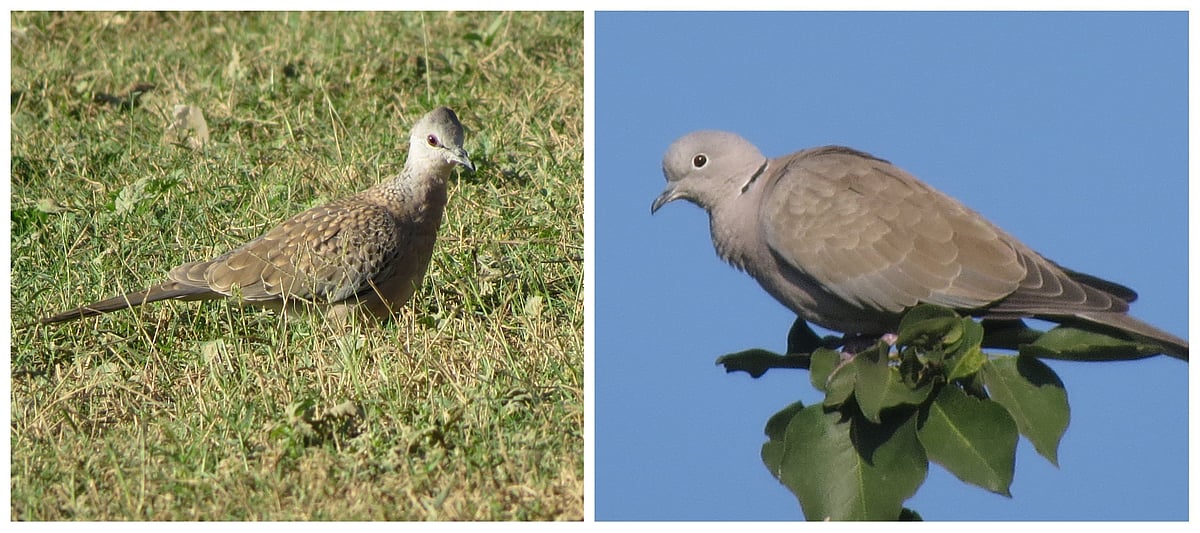‘Laughing’ Doves of the Subcontinent
Doves belong to the same family as pigeons. The North American species is called the ‘mourning doves’. The deep, gentle cooing of some doves actually sounds like a mourning dirge

Doves, symbols of peace and love, are often seen at public functions. These symbolic doves are usually pure white and smaller pigeons, selectively bred in captivity to be used as ‘release birds’ at inauguration ceremonies of international games, peace conferences, parades and pageants. The actual cooing doves seen around human habitation and in the wild are a more earthy brown.
Doves belong to the same family as pigeons- Columbidae. The name comes from Latin Columbas meaning dove. In English language, the larger birds are called pigeons and the smaller ones are called doves.
They are capable of strong and swift flights. A flock of doves is called a dule (pronounced as dool) derived from the French word deuil meaning a mourning. The deep, gentle cooing of some doves actually sounds like a mourning dirge.
There are five well-known species of Doves found on the Indian Subcontinent. All of them are widely distributed and resident birds. The first one is happily called a Laughing Dove (Stigmatopelia senegalensis). Its closest North American cousin, on the other hand is called a Mourning Dove. Its soft cooing often resembles the gurgling laughter of a baby. It is a slim, small pinkish-brown dove with a long tail and black stippling on upper breast. It essentially feeds terrestrially on seeds and small insects and beetles.
My next favourite is the Spotted Dove (Stigmatopelia chinensis). This dove has an even wide range of distribution that includes the Himalayan Terai, all the Northeastern states and Sri Lanka. A medium sized dove of ~30 cm, it is pinkish brown in color, with buffish pink spotting or scaling on the upper parts and a black-and-white chequered patch on the side of the neck. The neck, breast and underparts are pink in color. The North-eastern subspecies Stigmatopelia chinensis tigrina has its upperparts finely scaled.

The third dove in our series is Eurasian Collared Dove (Streptopelia decaocto). As the name suggests, it is widely distributed over all of Europe and Asia, and has even been introduced into Northern America, Japan and Korea. At 32 cm, it is larger than the two earlier mentioned doves and almost the same size as a common pigeon. The dove has a dark half collar edged with white. It has a red iris that appears black from a distance.
The fourth Indian dove is Oriental Turtle Dove (Streptopelia orientalis). It is the largest of Indian Doves at 33 cm. It has rufous scaling on the wings and dusky underparts. The neck has a black-barred patch. The tips of the wings and tail are grey in colour. The scales on the upperparts give the bird its name Turtle Dove.
The last of Indian Doves is the Red Collared Dove (Streptopelia tranquebarica). It is the smallest of the five at a mere 23 cm. It is widely distibuted all over India except in Kerala and Tamil Nadu, and Northern Himalayas. The male has a blue-grey head, a black half collar on the nape of neck and pinkish maroon upper parts and plain pink underparts. The female is visibly smaller and has darker buff grey underparts and darker fawn-brown upper parts.
And now that we have been introduced to all the five species, we can go out and spot them in our backyard birding. The doves are easy to find close to human habitation and a delight to watch. Their soft cooing is a different music to human ears. We just need to remember that a wild dove is not Una Paloma Blanca but more of Una Paloma Sepia!
Follow us on: Facebook, Twitter, Google News, Instagram
Join our official telegram channel (@nationalherald) and stay updated with the latest headlines
